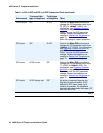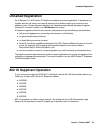
Dynamic Addressing Process
Issue 6 February 2007 39
3. Using the list of gateway IP Addresses provided by the DHCP server, the telephone
performs a router check. The telephone cycles through the gateway IP Addresses with
ARPs or pings until it receives a response. During this search, the 4601’s Call Appearance
Line b indicator flashes continuously 500 milliseconds on, 500 milliseconds off. All other
4601 LEDs remain lit.
When the router is located, the TFTP or HTTP process starts. If no router is found for a
4601/4601+ IP Telephone, its Call Appearance Line b flutters 50 milliseconds on, 50
milliseconds off three times. All other 4601 LEDs remain lit, and a reset occurs.
4. As of software Release 2.8, a new system value FILTERLIST had been added, which
allows IP Source Addresses to be filtered for additional security. For more details, see
Chapter 2, “Security” in the 4600 Series IP Telephone LAN Administrator Guide.
TFTP/HTTP Processing
The IP telephone connects to the TFTP or HTTP/HTTPS server and looks for an upgrade
script file.
During TFTP or HTTP processing for the 4601/4601+ IP Telephone, both Call Appearance
Line indicators flash continuously 500 milliseconds on, 500 milliseconds off while all other
LEDs remain lit. If the appropriate information cannot be discerned or is missing, both of the
4601’s Call Appearance Line indicators flutter 50 milliseconds on, 50 milliseconds off three
times. All other 4601/4601+ LEDs remain lit, and a reset occurs.
1. The TFTP or HTTP server sends and identifies an upgrade script.
The read request packet might have to be sent several times. Each time the RRQ message
is sent, all IP telephones except the 4601/4601+ display one of the following messages:
For TFTP, # is the number of TFTP requests made by the telephone and www.xxx.yyy.zzz
is the IP Address of the current TFTP request. For HTTP, n is the number of HTTP requests
made by the telephone and uri is the URI for the current HTTP request.
2. While the upgrade script file is being downloaded, all IP telephones except the 4601/4601+
display the following message:
where n is the number of KBs received from the TFTP server.
TFTP: #
www.xxx.yyy.zzz
HTTP: n uri
46xxUPGRADE.SCR
n KB received


















